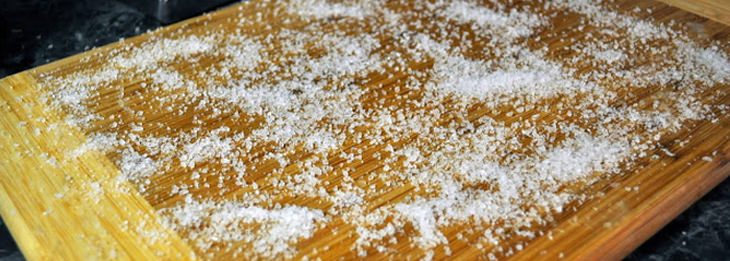There seems to be no one in the modern
world without salt in their kitchen. This white seasoning is used in
almost every dish we prepare, but it has many other uses that you should
know about. Today you’ll learn 10 ways you can use salt to make
cleaning so much easier for yourself. I recommend doing number 8 every
weekend.
1. Clean broken eggs
Did you accidentally drop an egg on the floor? Cleaning it up will
require lots of paper towels unless you use this tip. Sprinkle salt on
the broken egg and let it be absorbed for a few minutes. You’ll then
only need one paper towel to clean up the mess.
2. Remove sticky residue from an iron
Is your iron a little sticky? Turn it on to maximum heat for a few
minutes. As it warms up, take wax paper or a newspaper and sprinkle salt
over it. Now move the iron in a circular motion over the salt - the
salt will catch the sticky residue and leave it on the paper.
3. Clean wine spilled on the carpet

Spilled some wine on the carpet? Whether red or white, you can easily
clean it up by pouring some baking soda on it and covering it with salt.
Let the salt absorb as much liquid as possible, and when the area
dries, simply vacuum up the salt and baking powder.
4. Clean lipstick stains from glasses 
Have you finished drinking some wine and left behind a lipstick stain?
If the stain is stubborn and doesn’t come out in the dishwasher or after
handwashing, simply rub some salt on to it and watch it disappear.
5. Clean and disinfect your wooden cutting
board
A cutting board can be a source of bacteria and disease if it's not
cleaned properly. Therefore, you should rub half a lemon over the wood,
pour salt on to it, wait 10-15 minutes, and then scrub with the lemon
again. If the lemon dries, squeeze it and continue cleaning.
6. Extinguish kitchen fires
If a fire suddenly starts in one of your pans, water will not
necessarily put it out, as it is likely that what’s burning is oil.
Instead of using water, quickly open your salt jar and just pour it over
the pan. The salt will prevent oxygen from reaching the fire and
suffocate it quickly so that you and the kitchen won’t be harmed.
7. Clean Pots and Pans
Did you burn your food and are now stuck with stubborn residue? The
simplest way to clean it is by pouring salt over the pan and adding
water. This mixture will help loosen all the burnt grime and after ten
minutes you can wash the pan easily. You can also use this method on
burnt oil in the oven.
8. Clean sponges
You washed the pan, but are now left with a black and dirty sponge? Just
fill a small container with 2 cups of water and a quarter cup of salt,
put the sponge in and leave it in there overnight. When you take it out
in the morning, it'll be like new. It's recommended doing this at least
once a week, whether the sponge is stained or not.
9. Clean ceramic tiles
Sometimes the usual detergents we buy
aren’t enough to clean ceramic tiling efficiently. If you want to
thoroughly clean the bathroom, mix together one cup of turpentine and
one cup of salt (wear protective gloves and open the windows as you
shouldn't breathe in the turpentine gases). Apply the paste onto a
sponge and scrub away. After about a minute, you'll see that the stains
you've gotten used to over the years will start to disappear.
10. Clear clogs
Cleaning the bathroom and suddenly realize that your drain’s clogged?
Here's what you need to do. First, remove any hairs stuck in the drain,
then mix a quarter cup of baking soda and a quarter cup of salt. Pour
the powder mixture directly into the drain, and then pour a half cup of
vinegar quickly over it. The solution will begin to foam and release the
clog within 15 minutes. Then just pour hot water into the drain to get
rid of any powder residue.


